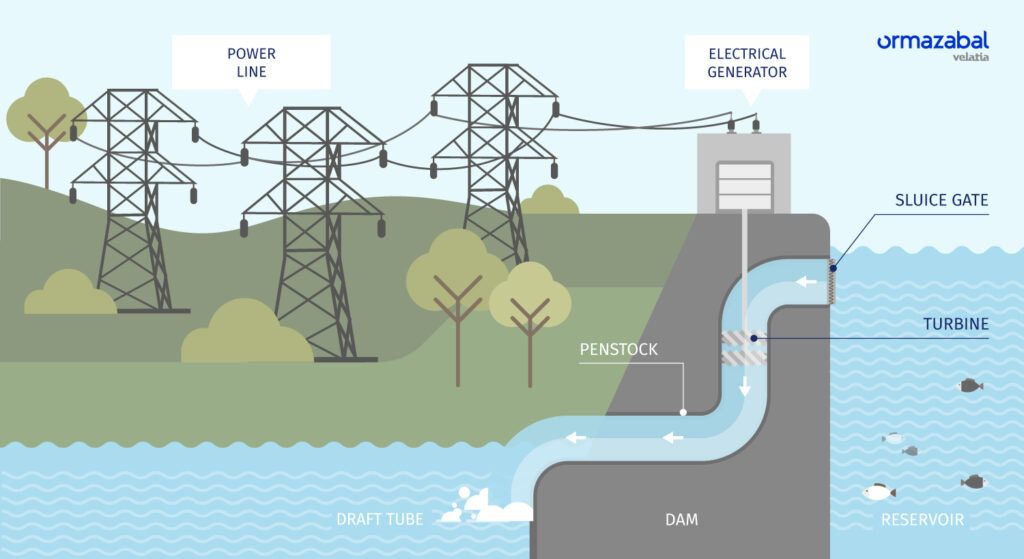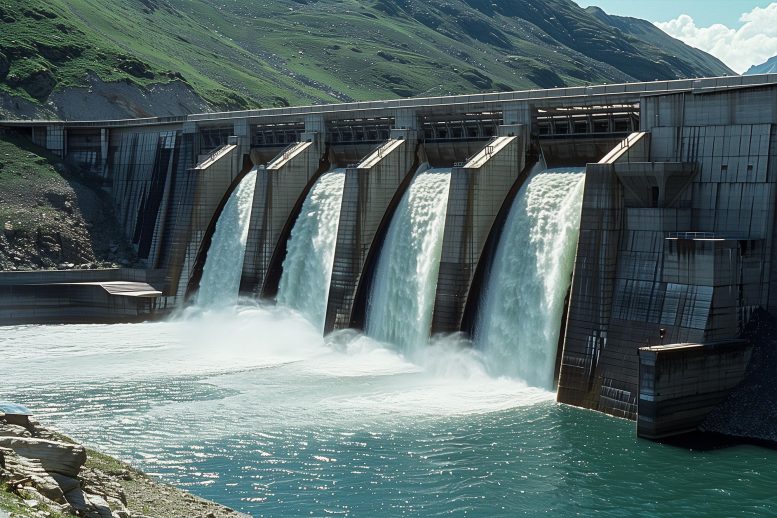
Hydropower is an attractive alternative to fossil fuels as it does not directly produce carbon dioxide or other atmospheric pollutants and it provides a relatively consistent source of power. Nonetheless, it has economic, sociological, and environmental downsides and requires a sufficiently energetic source of water, such as a river or elevated lake. International institutions such as the World Bank view hydropower as a low-carbon means for economic development. Since ancient times, hydropower from watermills has been used as a renewable energy source for irrigation and the operation of mechanical devices, such as gristmills, sawmills, textile mills, trip hammers, dock cranes, domestic lifts, and ore mills. A trompe, which produces compressed air from falling water, is sometimes used to power other machinery at a distance.
A hydropower resource can be evaluated by its available power. Power is a function of the hydraulic head and volumetric flow rate. The head is the energy per unit weight (or unit mass) of water. The static head is proportional to the difference in height through which the water falls. Dynamic head is related to the velocity of moving water. Each unit of water can do an amount of work equal to its weight times the head. The power available from falling water can be calculated from the flow rate and density of water, the height of fall, and the local acceleration due to gravity:


Main articles: Hydroelectricity § Disadvantages, and Renewable energy debate § Hydroelectricity Some disadvantages of hydropower have been identified. Dam failures can have catastrophic effects, including loss of life, property and pollution of land. Dams and reservoirs can have major negative impacts on river ecosystems such as preventing some animals traveling upstream, cooling and de-oxygenating of water released downstream, and loss of nutrients due to settling of particulates. River sediment builds river deltas and dams prevent them from restoring what is lost from erosion. Furthermore, studies found that the construction of dams and reservoirs can result in habitat loss for some aquatic species. Large and deep dam and reservoir plants cover large areas of land which causes greenhouse gas emissions from underwater rotting vegetation. Furthermore, although at lower levels than other renewable energy sources,[citation needed] it was found that hydropower produces methane equivalent to almost a billion tonnes of CO2 greenhouse gas a year. This occurs when organic matters accumulate at the bottom of the reservoir because of the deoxygenation of water which triggers anaerobic digestion. People who live near a hydro plant site are displaced during construction or when reservoir banks become unstable. Another potential disadvantage is cultural or religious sites may block construction.


Applications A shishi-odoshi powered by falling water breaks the quietness of a Japanese garden with the sound of a bamboo rocker arm hitting a rock. Mechanical power Watermills This section is an excerpt from Watermill.[edit] Watermill of Braine-le-Château, Belgium (12th century) Interior of the Lyme Regis watermill, UK (14th century) A watermill or water mill is a mill that uses hydropower. It is a structure that uses a water wheel or water turbine to drive a mechanical process such as milling (grinding), rolling, or hammering. Such processes are needed in the production of many material goods, including flour, lumber, paper, textiles, and many metal products. These watermills may comprise gristmills, sawmills, paper mills, textile mills, hammermills, trip hammering mills, rolling mills, and wire drawing mills. One major way to classify watermills is by wheel orientation (vertical or horizontal), one powered by a vertical waterwheel through a gear mechanism, and the other equipped with a horizontal waterwheel without such a mechanism. The former type can be further subdivided, depending on where the water hits the wheel paddles, into undershot, overshot, breastshot and pitchback (backshot or reverse shot) waterwheel mills. Another way to classify water mills is by an essential trait about their location: tide mills use the movement of the tide; ship mills are water mills onboard (and constituting) a ship. Watermills impact the river dynamics of the watercourses where they are installed. During the time watermills operate channels tend to sedimentate, particularly backwater. Also in the backwater area, inundation events and sedimentation of adjacent floodplains increase. Over time however these effects are cancelled by river banks becoming higher. Where mills have been removed, river incision increases and channels deepen. Compressed air See also: Trompe A plentiful head of water can be made to generate compressed air directly without moving parts. In these designs, a falling column of water is deliberately mixed with air bubbles generated through turbulence or a venturi pressure reducer at the high-level intake. This allows it to fall down a shaft into a subterranean, high-roofed chamber where the now-compressed air separates from the water and becomes trapped. The height of the falling water column maintains compression of the air in the top of the chamber, while an outlet, submerged below the water level in the chamber allows water to flow back to the surface at a lower level than the intake. A separate outlet in the roof of the chamber supplies the compressed air. A facility on this principle was built on the Montreal River at Ragged Shutes near Cobalt, Ontario, in 1910 and supplied 5,000 horsepower to nearby mines.
